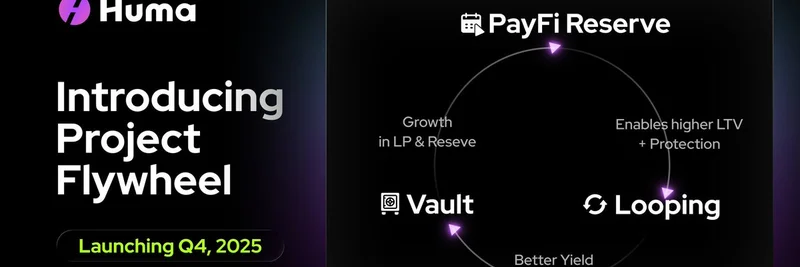Huma Finance, a leading player in the PayFi network, just dropped some exciting news via their X thread. They're introducing Project Flywheel, a game-changing initiative designed to give Huma and the broader PayFi ecosystem a serious edge over traditional finance (TradFi). Set to launch in Q4 2025 on the Solana blockchain, this project combines three key components: Looping, Reserve, and Vault. Let's break it down in simple terms and see why it's buzzing in the crypto community.
Understanding PayFi and Why It Matters
Before diving into the details, a quick explainer: PayFi stands for Payment Finance, blending decentralized finance (DeFi) with real-world payment systems. It allows for instant liquidity and global payments without the usual hassles of banks. Huma Finance is at the forefront, accelerating these payments anytime, anywhere. Project Flywheel builds on this by creating a self-reinforcing cycle—think of it like a flywheel that gains momentum as it spins, driving growth and efficiency.
The Power of Looping in PayFi
At the heart of Project Flywheel is Looping, a DeFi innovation that's tough for TradFi to replicate. In simple words, Looping lets users reuse their yields (earnings from investments) to compound returns over time. For PayFi, this means higher and more consistent yields, making it an ideal showcase for this tech. Imagine earning interest on your crypto, then automatically using that interest to earn even more—it's like interest on steroids, supercharging your portfolio without extra effort.
Huma PayFi Reserve: Your Safety Net
Next up is the Huma PayFi Reserve, built natively on Solana as a backstop against rare but severe risks. Here's how it works:
- Deposits and Yields: By depositing HumaSOL (Huma's Solana-based token) into the Reserve, you earn a share of premium yields.
- Protection Layer: It acts as a safety net for PayFi and Real-World Assets (RWA) on Solana, covering potential catastrophes.
- Institutional Boost: This setup speeds up adoption by big players, as it adds a layer of security that institutions crave.
In essence, the Reserve not only protects the ecosystem but also rewards participants, creating a win-win for growth and stability.
Huma Vault: Bridging Growth and Token Demand
Rounding out the trio is the Huma Vault, which connects protocol expansion with demand for the $HUMA token. Key features include:
- Automated Yields: It optimizes yield strategies automatically, so you don't have to micromanage.
- Staking and Demand: Drives up demand for $HUMA through staking incentives.
- Buybacks: A portion of the Vault's income goes toward buying back $HUMA tokens, potentially increasing their value.
This component aligns incentives across the board, ensuring that as the protocol grows, so does the token's utility and scarcity.
What This Means for the PayFi Ecosystem
Project Flywheel isn't just a fancy name—it's a strategic move to scale Huma's operations while providing tangible benefits like higher Loan-to-Value (LTV) ratios, better yields, and robust protection. By integrating Looping, Reserve, and Vault, Huma is positioning PayFi as a superior alternative to TradFi, especially on the fast and efficient Solana network.
For blockchain enthusiasts and DeFi users, this could mean more opportunities for passive income and risk-managed investments. If you're curious for more details, check out the full announcement on Huma's blog.
As the crypto space evolves, innovations like Project Flywheel highlight how PayFi is bridging the gap between traditional payments and decentralized tech. Stay tuned for the Q4 2025 launch—it might just be the catalyst for the next wave of adoption.



